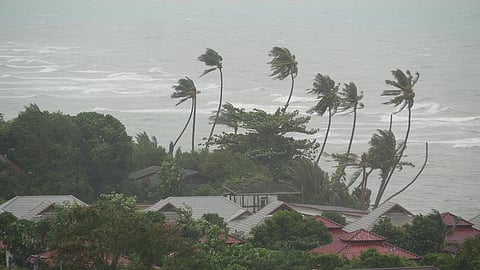

The cyclonic storm Mocha may change its course from the earlier prediction of making landfall in Odisha and West Bengal, as it is likely to move towards Myanmar, according to weather forecast website Windy.
The cyclonic circulation, likely to develop over the southeast Bay of Bengal around May 6, would concentrate into a depression over 24 hours, the India Meteorological Department (IMD) said on May 4, 2023.
In its official statement, the IMD predicts the depression to intensify and develop into a cyclonic storm by May 8 and move northwards towards the Bay of Bengal.
However, the officials claim that it is too early to trace the exact path of the cyclone and the picture will be clear only after the formation of low pressure area.
“It is expected that an upper cyclonic circulation in the upper atmosphere will form by May 6. It will be followed by a lower cyclonic circulation on Sunday. This is expected to happen if the conditions conducive to form a cyclone continue,” said Anupam Kashyapi, head of IMD’s weather forecasting department.
Once the system is formed, it is expected that the circulation will lead to a depression by the evening of May 8, Kashyapi said.
“However, the track of the cyclone will only become clearer once the system is formed. Considering the existing conditions and climate models, it is predicted that the cyclone will skirt India and Bangladesh through south coastal areas, Odisha and southeast Gangetic West Bengal,” he added.
The official said the conditions or the process of cyclone formation has been slightly delayed than expected.
The cyclonic formation is likely, but the steering winds are not clear to help understand the path of the cyclone, said Raghu Murtugudde, a climate scientist at the University of Maryland and Indian Institute of Technology, Bombay.
Murtugudde told DownTo Earth:
It is too early to know as cyclone formation is still 4-5 days away. But the winds have been anomalous. There are cooler weather conditions in India and no severe heatwaves, which may be the reasons for the uncertainty in predicting the cyclone’s direction.
Murtugudde added that Mumbai and Delhi have seen cooler summers in the past couple of months which is an anomaly considering the peak summer months. “As the winds are not normal, it may affect the course of cyclone,” he said.
However, the Bay of Bengal has warmed quite a bit in March and April. “It is something to worry about. Warm ocean often lead to rapid intensification (RI) of cyclones,” he said.
RI is defined as the shooting up of maximum sustained wind speed by at least 55 km per hour within a 24-hour period. “Such acceleration comes with a rapid drop in the pressure in the eye of a cyclone,” he explained.
Considering the cyclone forming moisture load, all ingredients exist for rapid intensification, he added.
Speaking about another cyclone forming in the southern Indian Ocean near Indonesia, Murtugudde said, “Twin cyclones are quite common and should not affect each other much as their direction is different. But it is to be watched whether the two cyclones meet over land and dump huge amounts of rain.”
On asking whether the prevailing conditions affect the monsoon, which is almost a month away, Murtugudde said the cyclone Mocha showing anti-clockwise movement might actually help to pull the monsoon winds towards India.
“More information needs to come from the IMD which will help understand the progress of cyclone. However, if the conditions occur, it will strengthen the monsoon cross equatorial flow,” said Debasish Jena, agrometeorology scientist, district agromet unit, Cuttack.
Between May 7 and 12, 2022, severe cyclonic storm Asani also exhibited multiple curvatures in its path. The models suggested the direction of the system from northwest to northeast near the coast for the cyclone that formed in the southern Bay of Bengal, according to IMD.
However, the deep depression moved towards the north and slowly to the west and southwestwards, concluding over Andhra Pradesh.